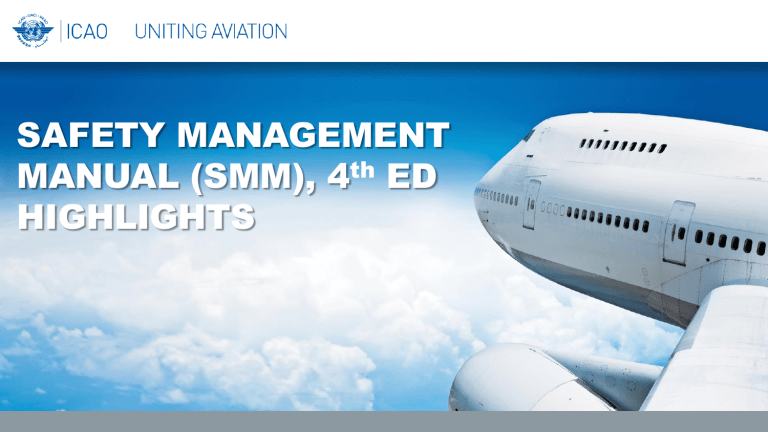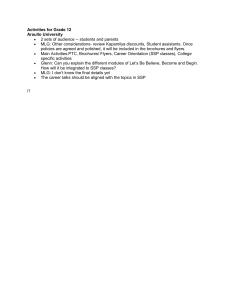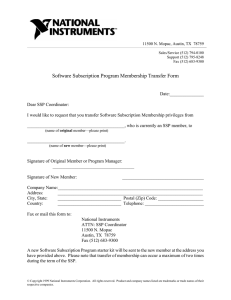
SAFETY MANAGEMENT MANUAL (SMM), 4th ED HIGHLIGHTS Evolution of SMM 2018 2013 SMM 3rd edition 2009 SMM 4th edition SMM 2nd edition 2006 1st SMM edition 16 key differences The advance unedited version of the 4th edition of the SMM is available for download from ICAO-NET Update was initiated To address the changes introduced by Annex 19, amendment 1 adopted on 2 March 2016 To reflect the knowledge and experience gained since the last revision Effective from 11 July 2016 Applicable from 7 November 2019 KEY DIFFERENCE 1 Fewer Pages 300 254 pages Less prescriptive to support tailoring to the needs and operational context of each organization More focused on the intended outcomes of each activity and process to support effective implementation 200 170 pages 100 0 SMM 3rd SMM 4th KEY DIFFERENCE 2 Complementary Safety Management Implementation (SMI) public website (www.icao.int/SMI) Many examples and tools from the 3rd edition of SMM updated and moved (not lost!!) to the SMI website Additional examples and tools will be collected, validated and posted on the SMI public website Free e-book version of advance unedited SMM included!!! KEY DIFFERENCE 3 SSP and SMS commensurate with the size and complexity General guidance on scalability contained in Chapter 1 The guidance has been updated with a focus on intended outcomes and performance in order to achieve effective implementation. “Commensurate with size and complexity” better explained and to be supported and by additional practical examples and tools on the SMI public website (www.icao.int/SMI) KEY DIFFERENCE 4 New Structure CHAPTER 1 - Introduction CHAPTER 2 - Safety management fundamentals CHAPTER 3 - Safety culture CHAPTER 4 - Safety performance management CHAPTER 5 - Safety data collection and processing systems CHAPTER 6 - Safety analysis CHAPTER 7 - Protection of safety data, safety information and related sources CHAPTER 8 - State safety management CHAPTER 9 - Safety management systems Safety management fundamentals Developing safety intelligence Safety management implementation KEY DIFFERENCE 5 The benefits of safety management Expected benefits of safety management are highlighted To support a clear understanding of what safety management, effectively implemented, can achieve KEY DIFFERENCE 6 The scope and applicability of safety management provisions Expanded introduction to address the scope of safety management provisions and their applicability Extension of discretionary SMS applicability newly added Guidance on applicability for State-owned or military aviation service providers KEY DIFFERENCE 7 Integrated Risk Management Introduction of the notion of integrated risk management in Chapter 1 to create awareness of the impact other domains have on the management of safety risk and vice versa Importance of focus on overall risk reduction for the organization (State or service provider) KEY DIFFERENCE 8 Entire chapters devoted to Safety culture and the Protection of safety data, safety information and related sources Guidance on the promotion of a positive safety culture Basic principles governing the protection of safety data and safety information, and guidance for the implementation KEY DIFFERENCE 9 Safety oversight CEs integrated with SSP elements Chapter 8 – State Safety Management Responsibilities reflects the SSP with the State safety oversight (SSO) system critical elements (CEs) as the foundation of SSP The CEs are integrated throughout the components as shown on the next slide The term “framework” is no longer used in reference to SSP Integrated State Safety Programme KEY DIFFERENCE 10 SSP Safety Promotion Due to the integration of the SSP elements with the SSO system, the State Safety Promotion Component is now focused on internal/external communication and dissemination of information Internal training of State personnel involved in the implementation of SSP is covered under Component 1 which now includes “Resources” in the title External training for industry is considered the responsibility of industry and is addressed under Component 2, Safety risk management as part of the acceptance of the SMS KEY DIFFERENCE 11 Training Needs Analysis (TNA) General guidance on performing a Training Needs Analysis in Chapter 9 for service providers, but can also be used for States to develop inspector competencies Training topics for accountable executives and senior managers are provided KEY DIFFERENCE 12 System description and interfaces General guidance on importance of a system description and identifying and managing interfaces contained in Chapter 1 Specific guidance directed at States under SSP Implementation in Chapter 8 Specific guidance directed at service providers under SMS Implementation in Chapter 9 System description Identification of interfaces Assessing safety impact of interfaces Managing and monitoring interfaces KEY DIFFERENCE 13 Safety objectives and Safety performance Strengthened link between safety objectives and safety performance in Chapters 4, 8 and 9 More flexibility in how the safety performance framework is defined KEY DIFFERENCE 14 Acceptable Level of Safety Performance (ALoSP) Specific guidance for States under State Safety Performance section in Chapter 8. The linkage between ALoSP and safety performance management activities of service providers is explained ALoSP represents an agreement between all the State aviation authorities of the expected level of safety performance that the aviation system should deliver CONTEXT OBJECTIVES SPIs & SPTs ALoSP agreed KEY DIFFERENCE 15 Management of change Enhanced guidance on Management of Change in Chapters 8 and 9 for States and service providers, respectively KEY DIFFERENCE 16 Integration of management systems Enhanced guidance on the integration of management systems, including the integration of SMS and QMS in Chapter 9 THANK YOU!



